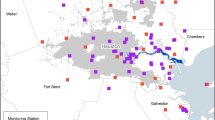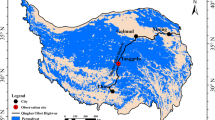Abstract
Elevated ground-level ozone is hazardous to people’s health and destructive to the environment. This research develops a novel data-integrated simulation to forecast ground-level ozone (SIMGO) concentration based on a real data set collected from seven monitoring sites in the Dallas-Fort Worth area between January 1, 2005 and December 31, 2007. Tree-based models and kernel density estimation (KDE) were utilized to extract important knowledge from the data for building the simulation. Classification and Regression Trees (CART), data mining tools for prediction and classification, were used to develop two tree structures in order to forecast ground-level ozone based on factors such as solar radiation and outdoor temperature. Kernel density estimation is used to estimate continuous distributions for the ground-level ozone concentration for seven days in advance. One week forecasts obtained from SIMGO for different months of a year is presented.








Similar content being viewed by others
References
Breiman, L., Friedman, J. H., Oishen, R. A., & Stone, C. J. (1984). Classification and regression trees. Belmont: Wadsworth.
Epanechnikov, V. A. (1969). Nonparametric estimation of a multivariate probability density. Theory of Probability and Its Applications, 14, 153–158.
Davis, J. M., & Speckman, P. (1998). A model for predicting maximum and 8 h average ozone in Houston. Atmospheric Environment, 33(16), 2487–2500.
Gardner, M. W., & Dorling, S. R. (1999). Statistical surface ozone models: an improved methodology to account for non-linear behavior. Atmospheric Environment, 34(1), 21–34.
Jones, M. C., Marron, J. S., & Sheather, S. J. (1996). A brief survey of bandwidth selection for density estimation. Journal of the American Statistical Association, 91(433), 401–407.
Kumar, A., Vedula, S., & Sud, A. (2000). Development of an ozone forecasting model for non-attainment areas in the state of Ohio. Environmental Monitoring and Assessment, 62(1), 91–111.
Lafore, R. (1991). Objected oriented programming in turbo C++. Indianapolis: Sams.
Lin, J.-T., Youn, D., Liang, X.-Z., & Wuebbles, D. J. (2008). Global model simulation of summertime US ozone diurnal cycle and its sensitivity to PBL mixing, spatial resolution, and emissions. Atmospheric Environment, 42(36), 8470–8483.
McClellan, R. O., Frampton, M. W., Koutrakis, P., McDonnell, W. F., Moolgavkar, S., North, D. W., Sith, A. E., Smith, R. L., & Utell, M. J. (2009). Critical considerations in evaluating scientific evidence of health effects of ambient ozone: a conference report. Inhalation Toxicology, 21(S2), 1–36.
North Central Texas Council of Governments (NCTCOG) (2011). Regional ozone information. http://www.nctcog.org/trans/air/ozone/. Accessed 10 January.
Sheather, S. J. (2004). Density estimation. Statistical Science, 19(4), 588–597.
Sheather, S. J., & Jones, M. C. (1991). A reliable data-based bandwidth selection method for kernel density estimation. Journal of the Royal Statistical Society. Series B, 53(3), 683–690.
Silverman, B. W. (1978). Choosing window width when estimating a density. Biometrika, 65(1), 1–11.
Sundaramoorthi, D., Chen, V. C. P., Rosenberger, J. M., Kim, S. B., & Behan, D. F. (2009). A data-integrated simulation model to evaluate nurse-patient assignments. Health Care Management Science, 12(3), 252–268.
Sundaramoorthi, D., Coult, A., & Nguyen, D. (2012, to appear). A data-integrated simulation of financial market dynamics. International Journal of Operations Research and Information Systems, 3(3).
Szintai, B., Kaufmann, P., & Rotach, M. (2010). Simulation of pollutant transport in complex terrain with a numerical weather prediction-particle dispersion model combination. Boundary-Layer Meteorology, 137(3), 373–396.
Temiyasathit, C., Kim, S. B., & Sule, N. V. (2007). Statistical modeling for the prediction of ozone concentrations in the Dallas-Fort worth area. In Proceeding of the 2007 industrial engineering research conference, Nashville, TN.
Thompson, M. L., Reynolds, J., Cox, L. H., Guttorp, P., & Sampson, P. D. (2001). A review of statistical methods for the meteorological adjustment of tropospheric ozone. Atmospheric Environment, 35(3), 617–630.
Torres-Jardón, R., García-Reynoso, J. A., Jazcilevich, A., & Ruiz-Suárez, L. G. (1995). Assessment of the ozone-nitrogen oxide-volatile organic compound sensitivity of Mexico City through an indicator-based approach: measurements and numerical simulations comparison. Journal of the Air & Waste Management Association, 59(10), 1155–1172.
U.S. Environmental Protection Agency (EPA) (2011a). OZONE—good high, bad nearby. http://www.epa.gov/glo/pdfs/ozonegb.pdf. Accessed 8 November 2011.
U.S. Environmental Protection Agency (EPA) (2011b). Understanding the clean air act. http://www.epa.gov/air/caa/peg/understand.html. Accessed 10 January 2011.
Vautard, R., Honore, C., Beekmann, M., & Rouil, L. (2005). Simulation of ozone during the august 2003 heat wave and emission control scenarios. Atmospheric Environment, 39(16), 2957–2967.
World Bank Group (WBG) (2011). Pollution prevention and abatement handbook. http://www.ifc.org/ifcext/enviro.nsf/AttachmentsByTitle/p_ppah_pguiGroundLevelOzone/$FILE/HandbookGroundLevelOzone.pdf. Accessed 8 November 2011.
Author information
Authors and Affiliations
Corresponding author
Appendix
Appendix
-
1.
Ground-level ozone (GO)
-
2.
Previous day’s ground-level ozone (PD_GO)
-
3.
Previous year’s ground-level ozone on the same day (PY_GO)
-
4.
Previous day’s nitric oxide level (PD_NOX)
-
5.
Previous year’s nitric oxide level on the same day (PY_NOX)
-
6.
Previous day’s solar radiation (PD_SR)
-
7.
Previous year’s solar radiation on the same day (PY_SR)
-
8.
Previous day’s outdoor temperature (PD_OT)
-
9.
Previous year’s outdoor temperature on the same day (PY_OT)
-
10.
Previous day’s wind speed (PD_WS)
-
11.
Previous year’s wind speed on the same day (PY_WS)
-
12.
Previous day’s maximum wind gust (PD_MWG)
-
13.
Previous year’s maximum wind gust on the same day (PY_MWG)
-
14.
Previous day’s resultant wind speed (PD_RWS)
-
15.
Previous year’s resultant wind speed on the same day (PY_RWS)
-
16.
Previous day’s resultant wind direction (PD_RWD)
-
17.
Previous year’s resultant wind direction on the same day (PY_RWD)
-
18.
Previous day’s standard deviation of horizontal wind direction (PD_HWD)
-
19.
Previous year’s standard deviation of horizontal wind direction on the same day (PY_HWD)
-
20.
Day of the week (D)
-
21.
Month of the year (M)
-
22.
Data collection location (L)
Rights and permissions
About this article
Cite this article
Sundaramoorthi, D. A data-integrated simulation model to forecast ground-level ozone concentration. Ann Oper Res 216, 53–69 (2014). https://doi.org/10.1007/s10479-012-1163-9
Published:
Issue Date:
DOI: https://doi.org/10.1007/s10479-012-1163-9




